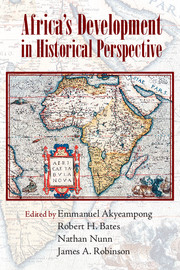Book contents
- Frontmatter
- Contents
- Author Biographies
- Acknowledgments
- Introduction
- Part I La Longue Durée
- Part II Culture, Entrepreneurship, and Development
- 5 Redistributive Pressures in Sub-Saharan Africa: Causes, Consequences, and Coping Strategies
- 6 Accumulation and Conspicuous Consumption: The Poverty of Entrepreneurship in Western Nigeria, ca. 1850–1930
- 7 Commerce, Credit, and Mobility in Late Nineteenth-Century Gold Coast: Changing Dynamics in Euro-African Trade
- 8 The Textile Industry of Eastern Africa in the Longue Durée
- 9 Explaining and Evaluating the Cash Crop Revolution in the “Peasant” Colonies of Tropical Africa, ca. 1890–ca.1930: Beyond “Vent for Surplus”
- 10 Reinventing the Wheel: The Economic Benefits of Wheeled Transportation in Early Colonial British West Africa
- 11 Mbanza Kongo/São Salvador: Culture and the Transformation of an African City, 1491 to 1670s
- Part III Institutions
- Part IV External Forces
- Index
- References
11 - Mbanza Kongo/São Salvador: Culture and the Transformation of an African City, 1491 to 1670s
Published online by Cambridge University Press: 05 September 2014
- Frontmatter
- Contents
- Author Biographies
- Acknowledgments
- Introduction
- Part I La Longue Durée
- Part II Culture, Entrepreneurship, and Development
- 5 Redistributive Pressures in Sub-Saharan Africa: Causes, Consequences, and Coping Strategies
- 6 Accumulation and Conspicuous Consumption: The Poverty of Entrepreneurship in Western Nigeria, ca. 1850–1930
- 7 Commerce, Credit, and Mobility in Late Nineteenth-Century Gold Coast: Changing Dynamics in Euro-African Trade
- 8 The Textile Industry of Eastern Africa in the Longue Durée
- 9 Explaining and Evaluating the Cash Crop Revolution in the “Peasant” Colonies of Tropical Africa, ca. 1890–ca.1930: Beyond “Vent for Surplus”
- 10 Reinventing the Wheel: The Economic Benefits of Wheeled Transportation in Early Colonial British West Africa
- 11 Mbanza Kongo/São Salvador: Culture and the Transformation of an African City, 1491 to 1670s
- Part III Institutions
- Part IV External Forces
- Index
- References
Summary
Since it is necessary to write many times about the city of São Salvador … Your Excellency should not be led to believe that it is a city like those of Europe; I have no doubt that in the past it was a lot better, given the ruins that exist.
Introduction
During the early decades of the Atlantic slave trade, slaving ports located on the Atlantic coast of Africa and localities far removed from the coast served as centers of trade as well as cultural contacts between Africans and Europeans. Although the economic impact of the trade in human beings has been the subject of numerous scholarly studies, less is known about the cultural dimensions of the trade. In fact, in no place in Atlantic Africa were the cultural ramifications as pronounced and different as in the kingdom of Kongo. Recent works by Kristin Mann on Lagos and Robin Law on Whydah (Kristin 2007; Law 2004) have contributed significantly to this issue as they have brought into focus the social dynamics that led to the rise and transformations of these two important Atlantic slave ports. Law’s use of the concept of the “middleman community” to explore the place of port cities in the Atlantic world is a good starting point for the study of Mbanza Kongo, and it also was a slave trade center. In some respects, however, Law’s “middleman community” does not fully represent the complexity of the social and cultural dynamics of Mbanza Kongo as the city not only served as an entrepôt for the slave trade with the Portuguese, but was also the capital of the kingdom. Unlike Lagos and Whydah and other port cities whose character was informed by the trade in slaves, Mbanza Kongo was the administrative and political capital of one of the most centralized states in Africa at the time. For more than a century after the arrival of the Portuguese in 1487, Kongo kings and nobles were guided not so much by the demands of the trade in slaves, but by imagining Mbanza Kongo as a new city. The ideas that they implemented transformed Mbanza Kongo into their version of the “Christian city.”
- Type
- Chapter
- Information
- Africa's Development in Historical Perspective , pp. 366 - 390Publisher: Cambridge University PressPrint publication year: 2014
References
- 2
- Cited by



